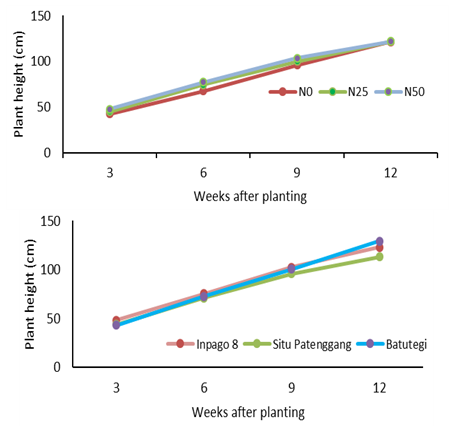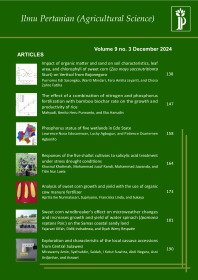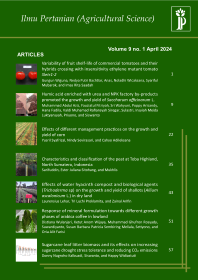
Response of upland rice (Oryza sativa L.) cultivars to different shade levels in sandy soil
Irwan Suluk Padang(1*), Tohari Tohari(2), Jaka Widada(3)
(1) Department of Agronomy, Faculty of Agriculture Universitas Gadjah Mada Jln. Flora no.1, Bulaksumur, Sleman, Yogyakarta 55281
(2) Department of Agronomy, Faculty of Agriculture Universitas Gadjah Mada Jln. Flora no.1, Bulaksumur, Sleman, Yogyakarta 55281
(3) Department of Microbiology, Faculty of Agriculture Universitas Gadjah Mada Jln. Flora no.1, Bulaksumur, Sleman, Yogyakarta 55281
(*) Corresponding Author
Abstract
The study aimed to determine the response of upland rice under different shade levels. The experiment was conducted in Srigading village, Sanden District, Bantul Regency, Yogyakarta from July 2016 to March 2017. The experimental design applied was the split-plot design with three replications. The main plot was the shade level consists of three levels i.e. 0%, 25% and 50%. The sub plot was the upland rice cultivar consists of three levels i.e. ‘Inpago 8’, ‘Situ Patenggang’, and ‘Batutegi’. The results showed that some variables observed changes due to shade that are make increased the plant height and leaf area. The maximum number of tillers and the number of productive tillers in the 50% shade treatment decreased, as well as the total plant dry weight and the productivity. Other observation such as root/shoot ratio, panicle length, percentage of filled grain per panicle, number of filled grains per panicle and 1000-grains weight upland rice showed no significant difference.
Keywords
Full Text:
PDFReferences
Alridiwirsah, H. Hanum, M.H. Erwin, Y. Muchtar, 2015. Uji toleransi beberapa varietas padi (Oryza sativa L.) terhadap naungan. Jurnal Pertanian Tropik, 2: 93-101.
Fraser, D. P., S. Hayes, and K. A. Franklin, 2016. Photoreceptor crosstalk in shade avoidance. Current Opinion in Plant Biology, 33: 1-7.
Gardner, F. P., R. B. Pearce, and R. L. Mitchell. 2008. Physiology of crop plants, 18th ed., translated by H. Susilo. Jakarta: Universitas Indonesia Press.
Gommers, C. M., E. J. Visser, K. R. St Onge, L. A.Voesenek, and R. Pierik, 2013. Shade tolerance: when growing tall is not an option. Trends in Plant Science, 18: 5-71.
Hutapea, J., Mashar, and A. Zum, 2012. Ketahanan pangan dan teknologi produktivitas menuju kemandirian pertanian Indonesia. Seminar Nasional Revitalisasi Pertanian Berkelanjutan Menuju Ketahanan Dan Kedaulatan Pangan. 1-12.
Jamil, A.; M.J. Mejaya; R. H. Praptana; N. A. Subekti; M. Aqil; A. Musaddad; and F. Putri, 2014. Deskripsi varietas unggul tanaman pangan 2009-2014, 1st ed., Jakarta: Pusat Penelitian dan Pengembangan Tanaman Pangan Kementerian Pertanian.
Jati, R.I., Tohari, and Suryanto, 2017. The optimum dose of nitrogen, phosporus, and potassium to improve soybean (Glycine max (L) Merr) productivity on Kayu Putih (Melaleuca cajuputi) stands. Ilmu Pertanian (Agricultural Science), 2: 56-63.
Moelyohadi, Y. 1999. Pengaruh naungan terhadap intersepsi dan efisiensi penggunaan radiasi surya pada tanaman padi gogo. Institut Pertanian Bogor. Bogor. (Thesis).
Romdon, A. S.; E. Kurniyati; S. Bahri; and J. Pramono. 2014. Kumpulan deskripsi varietas padi, 2nd ed., Ungaran: BPTP Jawa Tengah Kementerian Pertanian.
Shiddieq J.; P. Sudira; and Tohari. 2017. Aspek dasar agronomi berkelanjutan, 1st ed., Yogyakarta: Gadjah Mada University Press.
Sinaga, A., D. Indradewa, and P. Suryanto, 2016. Effect of the substitution of compound fertilizer with single fertilizer and mycorrhizal inoculation on the growth and yield of soybean among eucalyptus. Ilmu Pertanian (Agricultural Science), 1: 62-66.
Sitompul S. M. and B. Guritno, 1995. Analisis pertumbuhan tanaman, 1st ed., Yogyakarta: Gadjah Mada University Press.
Sopandie, D., M. A. Chozin, S. Sastrosumarjo, T. Juhaeti, and Sahardi. 2003. Toleransi padi gogo terhadap naungan. Jurnal Hayati, 10: 71-75.
Sulistyono E., M. A. Chozin and F. Rezkiyanti, 2002. Uji potensi beberapa galur padi gogo (Oryza sativa L.) pada beberapa tingkat naungan. Buletin Agronomi, 30: 1-5.
Sundari, T., Soemartono, Tohari, and W. Mangoendidjojo. 2005. Tingkat kritis intensitas cahaya relatif lima genotip kacang hijau (Vigna radiatus L.). Buletin Agronomi, 33: 33-39.
Vandenbussche, F., R. Pierik, F. F. Millenaar, L. A. Voesenek and D. V. D. Straeten, 2005. Reaching out of the shade. Current Opinion in Plant Biology, 8: 62-468.
Wang, L., F. Deng, and W. J. Ren. 2015. Shading tolerance in rice is related to better light harvesting and use efficiency and grain filling rate during grain filling period. Journal Field Crops Research, 180: 54-62.
Widarto, Y. P. and J. Susilo. 2004. Introduksi beberapa varietas unggul baru padi gogo di Kabupaten Blora. Prosiding Seminar Nasional Hasil Penelitian Pertanian, Perikanan dan Kelautan. 96-100.
Wirawati, T. 2006. Pengaruh intensitas naungan dan pupuk urea terhadap pertumbuhan dieffenbachia. Ilmu Pertanian (Agricultural Science), 13:41-150.
Article Metrics
Refbacks
- There are currently no refbacks.
Ilmu Pertanian (Agricultural Science) ISSN 0126-4214 (print), ISSN 2527-7162 (online) is published by Faculty of Agriculture Universitas Gadjah Mada collaboration with Perhimpunan Sarjana Pertanian Indonesia (PISPI) and licensed under a Creative Commons Attribution-ShareAlike 4.0 International License.













